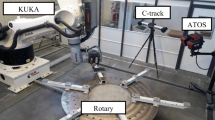Abstract
Industrial robots for machining applications have been researched to achieve an alternative, flexible and less expensive machining technology against conventional machine tools. The previous work on industrial robots indicates that industrial robots are only applicable without requirement of high accuracy. The low accuracy and instability under various configurations of industry robot are still major barriers for deploying robots for machining in industries. In this paper, a new method, namely historical data based correction (HDC), is presented to improve the accuracy of industrial robots for milling operations. First, the HDC method is able to calculate the corrected values to compensate the systematical errors during milling operations. Consequently, new tool paths of robots with corrected values are generated. In addition, the HDC method is able to fulfill the requirement of large-scale production. With the proposed method, the surface quality of the machined parts can be improved by more than 60 % without using any additional measuring systems.

















Similar content being viewed by others
Notes
Tool-Rotation indicates the orientation around the spindle axis.
References
Abele E, Bauer J, Hemker T, Laurischkat R, Meier H, Reese S, von Stryk O (2011) Comparison and validation of implementations of a flexible joint multibody dynamics system model for an industrial robot. CIRP J Manuf Sci Technol 4(1):38–43. doi:10.1016/j.cirpj.2011.01.006 (Special Section on Innovative and Cognitive Manufacturing Engineering)
Abele E, Polley W, Ehm A, Troue M (2013) Machining with industrial robots : Thermal influences on the machining precision. Werkstattstechnik online : wt, Springer VDI Verlag, Düsseldorf 103(9):706–7011. http://tubiblio.ulb.tu-darmstadt.de/62872/
Abele E, Rothenbücher S, Weigold M (2008) Cartesian compliance model for industrial robots using virtual joints. Prod Eng 2(3):339–343. doi:10.1007/s11740-008-0118-0
Abele E, Schützer K, Bauer J, Pischan M (2012) Tool path adaption based on optical measurement data for milling with industrial robots. Prod Eng 6(4):459–465. doi:10.1007/s11740-012-0383-9
Appleton E, Williams D (1987) Industrial Robot Applications. Open University Press. doi:10.1007/978-94-009-3125-1
Höfener M, Schüppstuhl T (2014) A method for increasing the accuracy of “on-workpiece” machining with small industrial robots for composite repair. Prod Eng 8(6):701–709. doi:10.1007/s11740-014-0570-y
ISO 9283 (1998) Manipulating industrial robots—performance criteria and related test methods, 2 edn. Committee ISO/TC 184/SC 2, ICS 25.040.30
Pan Z, Zhang H (2008) Robotic machining from programming to process control. In: Intelligent control and automation, 2008. WCICA 2008. 7th World Congress on, pp 553–558. doi:10.1109/WCICA.2008.4594434
Puzik A (2011) Increasing the machining accuracy of industrial robots by applying an active error compensation using a 3d-piezo compensation machanism. Ph.D. thesis, University of Stuttgart, Heimsheim. http://elib.uni-stuttgart.de/opus/volltexte/2012/6929
Slavkovic N, Milutinovic D, Glavonjic M (2014) A method for off-line compensation of cutting force-induced errors in robotic machining by tool path modification. Int J Adv Manuf Technol 70(9–12):2083–2096. doi:10.1007/s00170-013-5421-z
Stokic D, Surdilovic D (1990) Simulation and control of robotic deburring. Int Robot Autom 5(3):107–115
VDI 2861 (1988) Assembling and handling; characteristics of industrial robots; testing of the characteristics. VDI-Gesellschaft Produktion und Logistik, ICS 25.040.30
Author information
Authors and Affiliations
Corresponding author
Rights and permissions
About this article
Cite this article
Krüger, J., Zhao, H., Reis de Ascencao, G. et al. Concept of an offline correction method based on historical data for milling operations using industrial robots. Prod. Eng. Res. Devel. 10, 409–420 (2016). https://doi.org/10.1007/s11740-016-0686-3
Received:
Accepted:
Published:
Issue Date:
DOI: https://doi.org/10.1007/s11740-016-0686-3




